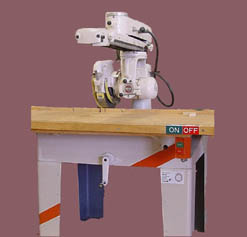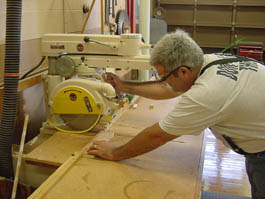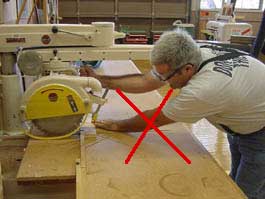Crosscutting with the
Radial Arm Saw
|
|
The radial arm saw is a multi-purpose tool. It not only crosscuts and rips lumber but it can also be configured for use as a jointer, drill, router, sander, and lathe. The saws primary function is crosscutting. It can make a variety of crosscuts including: straight, miter, bevel, dadoe, and rabbet cuts. This sheet describes the procedure for crosscutting stock to length. For other operations ask your instructor or refer to one of the many texts available. |
Controls: The controls on the radial arm saw in the materials processing laboratory consist of the following:
- A magnetic power switch that must be reset if the power in the laboratory is interrupted.
- An elevating crank located in front of the saw used to adjust cutting depth.
- A track locking lever located at side of travel arm used to adjust travel.
- Adjustable anti kickback finger located in front of blade to hold stock
- A bevel clamp located at the front of the saw used to adjust bevel angle.
- A miter clamp located at the top of the saw used to adjust miter angle.
Note: There are other controls and accessories used with the saw that are not listed.
Potential hazards: Because of the saws cutting ability and rotating blade, the following hazards exist.
- Contact with the blade will result in injury.
- Clothing or other articles may become entangled and pull the operator into the blade.
- Foreign material in the wood may cause the saw to jump forward.
- Airborne wood and saw dust may cause injuries, particularly to the eyes.
- The operator could slip and fall into the saw.
Safety practices: Because of the above listed hazards the following safety rules must be followed.
- Do not operate the saw if you are unfamiliar or uncomfortable with its use.
- Before cutting, inspect the stock for loose knots, metal, or any other hazards.
- Clear the cutting table of any objects that could enter the blades path.
- Keep the floor and area around the saw clean and free from any tripping or slipping hazards.
- Inspect the saw blade for defects and insure that it properly secured.
- Make sure that all locking handles are tight.
- Adjust blade to proper cutting depth.
- Slide the saw back and forth to insure it travels freely.
- Make sure all guards are in place and function properly.
- Always wear approved safety glasses.
- Never work alone.
- Avoid wearing loose clothing or jewelry that might get caught in the saw.
- Make sure power is off and the blade has stopped before making any adjustments.
- Unplug the saw before changing or working near blade.
- Never cut round stock.
- Never cut more than one piece of stock at a time (don't stack).
- Never cut stock that is shorter than the blade diameter.
- After making a cut, return the saw to its rearward position..
- Remain focused on cut do not allow yourself to be distracted.
- Hold stock firmly against fence while cutting.
- Never cut stock that doesn't lay flat on the table.
- Use table extensions or hold down clamps to control long stock.
- Keep hands and arms out of the blades path.
- Turn off the saw to clear any materials from near the blade.
- Change blade if you notice smoking, burning, or wavering during cut.
- Turn off saw if you encounter any unusual problems or sounds.
Crosscutting: Crosscutting is the operation used to cut stock to a desired length. The operator holds the stock in place against the fence and pulls the blade across the stock to make the cut. Refer to the following instructions.
- Inspect stock for defects and foreign material that may fly loose during cutting.
- Clear cutting table of any objects that may enter blade travel path.
- Inspect saw to ensure guards are in place and that blade is secure and in good condition.
- Make sure the saw travels back and forth freely.
- Set blade height so that it cuts no more than 1/16" below surface of cutting table.
- Set miter position indicator to desired angle and secure clamp. You should check the miter angle by cutting and measuring a scrap piece.
- Measure stock and mark the cutting point.
- Make sure saw is in it's rearward position.
- Start saw and let it reach its maximum speed before cutting.
- Hold stock firmly against fence making sure that its laying flat on the table.
- Make sure arms are not crossed in front of saw.
- Pull the saw forward to make the cut.
- Push the saw rearward to its stating position.
- Turn off the saw and wait for the blade to stop before removing stock.
Note: To learn about other operations using the radial arm saw, consult with your instructor or shop supervisor. Do not attempt any operation that you are unfamiliar with.
|
|
|
|
Proper position for cutting. Stock must be held firmly against the fence while making the cut. Never cross your arm in front of the blade while crosscutting. |
Improper position for cutting. Note that the operators left hand is in the path of the blade. The cutting table must be clear of any items that may enter the blades travel path. |
References:
Spence, William T., (1981). Woodworking. American Technical Publishers. Alsip, IL.
Feirer, John L. (1988). Cabinet making and Millwork. Chas A. Bennett Company. Peoria, IL.
ITT 252 - Materials Processing
Department of Technology
University of Southern Maine
Prepared by Steven Burgess, 9/25/2001


